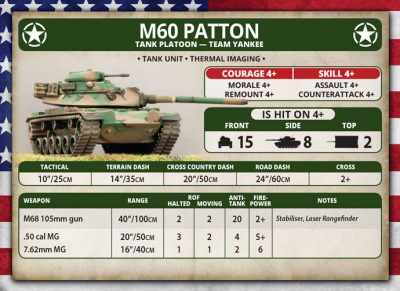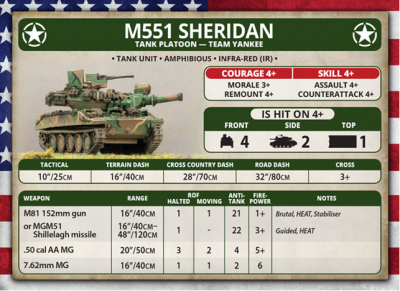Maneuver in Team Yankee
By No_Dice_Dane
In January, NDNG looked at the “equalization” of the US Air Defense Artillery protective umbrella resulting from the release of Stripes. That Article :
Stripes has provided the US player with the agile M551 Sheridan. Not realized in the game, the Sheridan was actually deployable by parachute airdrop.Background:- Post-Vietnam Era
The military had just been through a complete withdrawal from Viet Nam. In the late 70s, Military tacticians went down many dark paths and “learned” wrong lessons from its experience in South East Asia.
In the air, Operation Rolling Thunder bombing Campaign started in March 1965 was supposed to bring the North Vietnamese to the peace talks table.
Instead, it strengthened the resolve of the NVA. North Vietnam did not have much of an air force. As a result of Rolling Thunder, the NVA was able to mount an effective defense against the bombing raids. Using surface-to-air missiles and radar-controlled anti-aircraft artillery, the NVA shot down hundreds of American planes over the course of the bombing campaign. As a result, pilots and aircraft weapon systems operators accounted for the majority of the American prisoners of war who were captured and held by NVA.
Some came out of Vietnam thinking: “If we can’t beat the Viet Cong, running around in pajamas and sandals (low-intensity), how are we supposed to beat the Soviets in tanks and armored personal carriers (high-intensity)?” In addition, during the late ‘70s, the US Military hamstrung itself with the “active defense” doctrine, believing that the US military could, at best, delay the Soviet hordes long enough to facilitate the evacuation of key leaders, fighting forces and some of western European population centers.
The Force Awakens
Many in the military despised the defensive doctrine and challenged senior leaders and policy wonks that the best the US military could hope for was another Dunkirk on the continent of Europe. The doctrinal concept of Airland Battle and “fighting out-numbered and winning” was born.
The Army sent its brightest midgrade officers to a special course for strategist and tacticians at Fort Leavenworth, Kansas. These new military thinkers were deemed “Jedi Knights.” They were taught to challenge the old and outdated defensive thinking leaders, and challenge every instance of “that’s the way we have always done it” mentality.
Low Altitude, Parachute Extraction (LAPES) provides Operational and Theater maneuverThese new Airland Battle Jedi Knights concentrated on the tenants of Initiative, Agility and Synchronization. Further, the Jedi Knights focused forces and fires on the exploitation of perceived WARSAW PAC weaknesses: tactical rigidity, predictable employment, and technical inferiority. This last part was also being addressed at the National Strategic level with President Reagan’s “Star Wars Initiative”.
Maneuver: Maneuver is the dynamic element of combat, the means of concentrating forces in critical areas to gain and to use the advantages of surprise, psychological shock, position, and momentum which enable smaller forces to defeat larger ones. More specifically, it is the employment of forces through movement supported by fire to achieve a position of advantage from which to destroy or to threaten destruction of the enemy. The object of maneuver at the operational level is to focus maximum strength against the enemy’s weakest point, thereby gaining strategic advantage. At this level, successful maneuver is achieved through skillful coordination of fire in depth with movement of large units. At the tactical level, maneuver contributes significantly to sustaining the initiative, to exploiting success, to preserving freedom of action, and to reducing vulnerability. Successful maneuver at this level depends upon skillful movement along indirect approaches supported by direct and indirect fires.
FM 100-5, Operations (1982)
Application to Team Yankee games
 Stripes has provided the US player with increased combat power and Maneuver. The M60 is the last in the improved M48 / M60 MBTs. It can be built in the A1 configuration or the A3 configuration. With a 20” cross-country dash and 24” road dash, the M60 Patton tank has plenty of maneuver to bring combat power to where it’s needed.
Stripes has provided the US player with increased combat power and Maneuver. The M60 is the last in the improved M48 / M60 MBTs. It can be built in the A1 configuration or the A3 configuration. With a 20” cross-country dash and 24” road dash, the M60 Patton tank has plenty of maneuver to bring combat power to where it’s needed.
The M68 105mm main gun has a moving ROF of 2, AT 20, FP 2+, stabilizers. The M60 has a respectable 15 Front Armor. The M60 has 8 Side and 2 Top Armor, providing US players with the same level of protection as the M1. On the first turn the M60 with its a 40” range can reach out and touch the enemy practically anywhere on the game board.

The M551 Sheridan provides light forces MBT strength. With a 28” cross-country dash and 32” road dash, the M551 Sheridan tank has rapid terrain eating maneuver. The M81 152mm main gun has a moving ROF of 1, AT 21, FP 1+, 16” range and stabilizers! The MGM51 Shillelagh Missile with a halted ROF reaches out to an incredible 48.”
As with any light tank, its increased maneuverability is outset by its aluminum armor. Its crew protection is Front Armor 4, Side Armor 2, Top Armor 1. The M551 Sheridan can certainly reach across the board and hit the enemy, but keep it covered because return fire is going to be deadly.
Finally, readdressing the M1, Stripes now provides the US Player with the M1 IP (Improved Production). The M1IP was produced between 1984 and 1986, fitting snuggly into the Team Yankee time-frame. The M1IP has the same 28” cross-country dash and 32” road dash, giving it the same maneuver as a light tank. The M68 105mm main gun has a moving ROF of 2, AT 20, FP 2+, and advanced stabilizers! With a 40” range, the M1 is lethal anywhere on the board. The M1 has enhanced armor systems that afford the crew increased protection levels with an unprecedented Front Armor 19, Side Armor 10, and Top Armor 2.
So, there are the three new US MBTs. Providing the US player a plethora of maneuverable combat power.
Until next time, keep your hatchets ready, and your powder dry! – Robert Rogers Roberts Rangers
